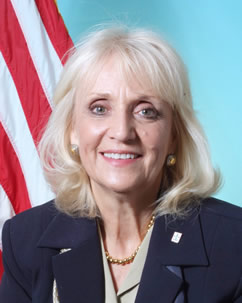Ms. Gayle A. Olszyk
 Gayle A. Olszyk was born on July 21, 1949 at Martin Army Hospital at Fort Benning, GA. She graduated from the University of Maryland with a Bachelor of Science in Education in 1972, followed by a Master’s degree in Education in 1975.
Gayle A. Olszyk was born on July 21, 1949 at Martin Army Hospital at Fort Benning, GA. She graduated from the University of Maryland with a Bachelor of Science in Education in 1972, followed by a Master’s degree in Education in 1975.
Olszyk spent her first years as an Army civilian at the U.S. Army Signal Center and School beginning in 1989. During her time at the Army Signal Center and School, she rose from head of the Skill Qualification Testing Branch to head of the Course Development Division to Chief of the Individual Training Branch to Chief of the Training Management Division by 1995. She transferred to Fort Monroe, VA, to become the Chief of the Programs Division in the Training Operations Management Activity of U.S. Army Training and Doctrine Command between 2000 and 2002.
In 2002, Olszyk became the Deputy to the Commander for the Ordnance Mechanical Maintenance School at Aberdeen Proving Ground, MD. As the senior civilian in her role as Deputy, she served as the senior advisor to the Chief of Ordnance, Commanding General, Ordnance Center and Schools, and the 61st Ordnance Brigade on all matters pertaining to the development, conduct, and resourcing of training for the Active and Reserve Component Soldiers and civilians in the Ordnance Corps. As conflicts in the Middle East started impacting training with increased training loads, reduced military instructors, and increased unit training missions, she led the school to identify additional alternative resources to continue training the load while meeting these new missions.
Because of her ability, after the September 2005 Congressional Base Realignment and Closure Commission (BRAC) announcement to move and consolidate the Ordnance Mechanical Maintenance School at Aberdeen Proving Ground and the Ordnance Munitions and Electronics Maintenance School at Redstone Arsenal to a new location at Fort Lee, VA, the Chief of Ordnance selected Olszyk to direct a team through the design, construction, and relocation of these facilities into a new, consolidated Ordnance campus.
Olszyk worked exhaustively to transform a once-wooded area on Fort Lee into a $1.2 billion state-of-the-art training facility that spans 3 million square feet, with 30 buildings that house training for more than 12,000 Soldiers and Marines annually. Olszyk also worked tirelessly with the garrison staff and contractors at Aberdeen Proving Ground and Redstone Arsenal to ship almost 30 million pounds of equipment in 830 truckloads to the Fort Lee campus. The complexity of this task cannot be overstated, as it sometimes involved shipping equipment immediately after a class at Redstone or Aberdeen so that it could be delivered, inventoried, and set up in time for training to start a new training day at Fort Lee. These extra efforts ensured no lost time for training throughout her strategic plan. As well, she led a team of resource analysts and subject matter experts that designed the organizational structure of the new Ordnance School and developed its Table of Distributions and Allowances.
Olszyk was relentless in ensuring there were no negative impacts on training. The Ordnance School trained its full programmed student load in 2010 and 2011 when the major BRAC moves occurred. The school provided Military Occupational Specialty (MOS) qualified Soldiers to the field on time with no decrement to training effectiveness as confirmed by the Combined Arms Support Command (CASCOM) Quality Assurance Office. Ms. Olszyk was the only senior leader, civilian or military, that remained with the school from the BRAC announcement through the establishment of the new Ordnance School and its construction at Fort Lee. Thanks largely to Olszyk’s leadership, expertise, strategic vision, and perseverance, the Ordnance School’s relocation to Fort Lee was completed ahead of the scheduled September 15, 2011 deadline with no negative impacts on training, and at about $100 million under the projected cost.
As she led the BRAC team, Ms. Olszyk continued her duties as the Deputy to the Commander, continuing to make significant contributions to the Ordnance School. She supported and guided the Ordnance Corps and School through several force structure initiatives, including the Ordnance Corps transformation to Two Level Maintenance and its impact on training and organizational structures in the units. Additionally, Ms. Olszyk was one of the initial creators of the Skills Based Training which dramatically changed the Ordnance School’s method and focus of training. Another major contribution was seen in the leadership she demonstrated orchestrating the MOS consolidation to create the new 91S, Stryker Maintainer.
Ms. Olszyk also managed the Ordnance School budget. She represented all Ordnance training serving as the single voice for the Ordnance School. As the senior civilian and career program manager, she was responsible for all civilian hiring actions, evaluations, and training. Ms. Gayle A. Olszyk retired on December 31, 2011.